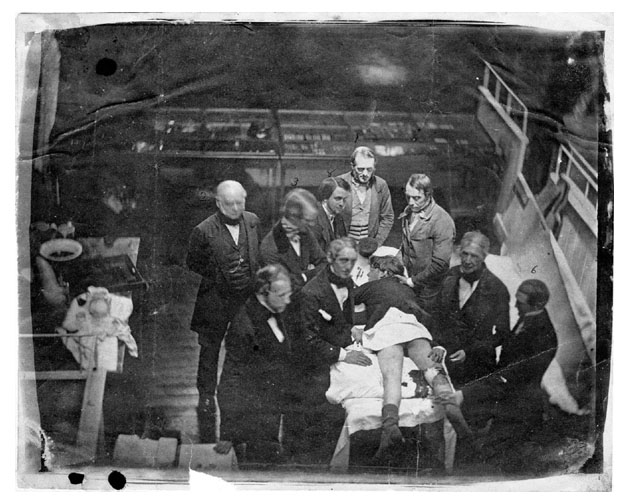
Boston : William D. Ticknor and Company, 1848.
Journal : Boston Medical and Surgical Journal ; vol. 35, no. 20 (Dec. 16).
Description : [1 l.] tp., [i]-v p., [1 l.] bt, 1-100 p., 1-4 p. adverts. ; 18.2cm.
Photographs [association] : Ether Dome Daguerreotypes Nos. 3-5.
Photographer : Josiah Johnson Hawes (1808–1901) of Southworth & Hawes.
Subject : Fibula – Spina ventosa (osseous sero-cystic tumor) ; diethyl ether anesthesia.
Notes :

Ether Dome Daguerreotype No. 5 – paper copy of a lost daguerreotype. Lead surgeon with his hand on the patient's thigh is John Collins Warren. Directly opposite him is his son, Jonathan Mason Warren. Holding the sponge and administering diethyl ether to the patient, Francis Manuel, is the anesthetist, Henry Bigelow. Standing next to him is his father, Dr. Jacob Bigelow. Archive: bequeathed by Henry K. Beecher, M. D., to the Library of Harvard Medical School, 1976.
Though his name is preeminent in the annals of ether anesthesia, John Collins Warren was not the innovator. Ether anesthesia was preconceived, emergent even, in the same way Tiphaigne de la Roche envisioned photography in 1760, long before the elements were in place to bring a desideratum into reality. What Daguerre accomplished for the dream of Tiphaigne with silver salts and iodine, Morton accomplished for the dream of pain-free surgery with diethyl ether, after scores of near misses by practitioners and experimenters who were familiar with ether's properties. Even Dr. Benjamin Franklin was reputed to have dosed neighborhood children with ether to elicit the antics of stupefaction that entertained their companions (Hosack, 1865; fn p. 360: »»). Valerius Cordus (1515-1544) entered diethyl ether into medical formulary in 1540, but it was known to the ancients as "sweet oil of vitriol," and Paracelsus had observed its anesthetic properties in chickens. As a medical practitioner, Warren was not alone in using ether to treat the pulmonary diseases of consumption and asthma, following the recommendation of Dr. Richard Pearson in 1795. He also had professional familiarity with ether as a palliative, a weakly diluted infusion in pillow sachets to treat insomnia, for example. Warren was, however, the first surgeon to operate with anaesthesia in a hospital setting, becoming the providential emissary of the "enchanted goblet." Ether doctrine was authenticated and established by Warren's reputation as a brilliant surgeon, and only the approbation of one so accomplished could vanquish institutional bias against what was considered a dangerous recreational narcotic. The courage of his declaration, "Gentlemen, this is no humbug," redounds in books on the history of surgery.
The first "Ether Day" took place on October 16, 1846, when Dr. Warren removed a congenital tumor from the neck of his patient, Edward Gilbert Abbott (1825–1855), after he was sedated by Morton. The surgery was conducted within the amphitheater of Boston's Massachusetts General Hospital, thenceforth enshrined as the "Ether Dome." Warren reported this operation and a quick succession of additional operations prosecuted with diethyl ether in a classic paper titled, "Inhalation of ethereal vapor for the prevention of pain in surgical operations," published in the Boston Medical and Surgical Journal (J. C. Warren, 1846: »»). Many historians believe that Ether Dome Daguerreotype No. 1 commemorates the Ether Day surgery, a fictionalized tableau vivant staged with an actor substituting for Abbott in the chair. It has become widely known as "The Reenactment Daguerreotype," however my scholarship disputes this scenario and attributes the image to Parkman's treatment of a dislocated surgery on December 9, 1846 – an enactment, not a re-enactment (see Rowley, 2022: »»).
Approximately one year later, Warren completed his monograph on the physiological actions of etherization, drawing from over two hundred cases prosecuted at Massachusetts General Hospital to constitute the first textbook on anaesthesia, titled, Etherization; with surgical remarks (J. C. Warren, 1848: »»). It is this work which includes the case notes for a remarkable exploratory and intervention surgery of a diseased fibula afflicting a young Portuguese seaman, Francis Manuel, who is portrayed in EDD Nos. 3-5. The thirty-minute surgery for a large osseous-serous tumor would have been impossible without anaesthetics, considering the peroneal nerve was involved and required its separation from the surface of the tumor (ibid ; p. 50-51: »»). The other two daguerreotypes were taken prior to the surgery and in one of these, known as EDD No. 3, Dr. Warren's son, J. Mason Warren, is seen palpating the mass on the side of Manuel's knee, indicating for the camera the surgical target site. During the operation a perforator was used on the fibula, but no sign of malignancy was found, so it was decided to "remove the externo-lateral wall of the bony tumour," and leave the question of its extirpation subject to "subsequent events." Swelling of the peroneal nerve recurred soon after the operation and Manuel went under the knife again on October 2, culminating in a transverse amputation of the lower leg, with sectioning of the young sailor's fibula up to the head. After the amputation Warren found no indications of a fracture in the dissected part, nor any signs of malignacy, and in his personal notes on the case he expressed dissatisfaction with the operation, thinking he could have spared the limb, but surmising that the limb would have remained "troublesome" in life ( E. Warren, "The Life of John Collins Warren, M.D." Boston, 1860: Ticknor & Fields; vol. 2, p. 191 »»).
